Soyuz 11: all hands lost
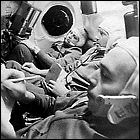 After a record-setting 22 day stay about Soviet space station Salyut 1, the crew of Soyuz 11 prepares to return home. As they undock and fire their retro rockets to bring their vehicle out of orbit, Soyuz depressurizes without warning, killing the crew – Georgi Dobrovolski, Vladislav Volkov and Viktor Patsayev – within a minute. (The cramped design of the Soyuz cabin makes no allowances for cosmonauts to wear spacesuits.) Soyuz flights will be grounded for two years until the vehicle can be redesigned to prevent another tragedy. Two members of the grounded prime crew, Alexei Leonov (the first man to walk in space) and Valery Kubasov, are later reassigned to the international Apollo-Soyuz mission in 1975.
After a record-setting 22 day stay about Soviet space station Salyut 1, the crew of Soyuz 11 prepares to return home. As they undock and fire their retro rockets to bring their vehicle out of orbit, Soyuz depressurizes without warning, killing the crew – Georgi Dobrovolski, Vladislav Volkov and Viktor Patsayev – within a minute. (The cramped design of the Soyuz cabin makes no allowances for cosmonauts to wear spacesuits.) Soyuz flights will be grounded for two years until the vehicle can be redesigned to prevent another tragedy. Two members of the grounded prime crew, Alexei Leonov (the first man to walk in space) and Valery Kubasov, are later reassigned to the international Apollo-Soyuz mission in 1975.
Soyuz 11
 After a tuberculosis scare forces Soviet space officials to ground the mission’s original crew, the backup crew of Soyuz 11 lifts off to become the first occupants of a manned space station. Experiencing none of the difficulties that plagued the earlier Soyuz 10 attempt to dock with Salyut 1, the Soyuz 11 crew stays aboard Salyut for 22 days, a new record for a manned space mission.
After a tuberculosis scare forces Soviet space officials to ground the mission’s original crew, the backup crew of Soyuz 11 lifts off to become the first occupants of a manned space station. Experiencing none of the difficulties that plagued the earlier Soyuz 10 attempt to dock with Salyut 1, the Soyuz 11 crew stays aboard Salyut for 22 days, a new record for a manned space mission.
Soyuz 10: technical difficulties
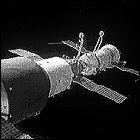 The Soviet Union launches the Soyuz 10 mission, intended to become the first crew to occupy an Earth-orbiting space station. Flying a new modification of the Soyuz vehicle, fitted with a new system for docking to the Salyut 1 space station, are Vladimir Shatalov, Alexei Yeliseyev and Nikolai Rukavishnikov, but they won’t be the first space station crew in history: the Soyuz capsule fails to hard-dock to the station, making it impossible for them to enter. Soyuz 10 returns to Earth after two days, and even on the return journey the cosmonauts are sickened by toxic fumes in their environmental system. Salyut 1 remains in orbit, still unmanned.
The Soviet Union launches the Soyuz 10 mission, intended to become the first crew to occupy an Earth-orbiting space station. Flying a new modification of the Soyuz vehicle, fitted with a new system for docking to the Salyut 1 space station, are Vladimir Shatalov, Alexei Yeliseyev and Nikolai Rukavishnikov, but they won’t be the first space station crew in history: the Soyuz capsule fails to hard-dock to the station, making it impossible for them to enter. Soyuz 10 returns to Earth after two days, and even on the return journey the cosmonauts are sickened by toxic fumes in their environmental system. Salyut 1 remains in orbit, still unmanned.
Salyut 1: the first space station
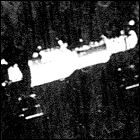 Salyut 1, the first orbiting space station in history is launched, unmanned, by the Soviet Union. With Salyut 1, the Soviet space program intends to vault ahead of the United States in a new space discipline (namely long stays in space and the study of human endurance in a zero-G environment), having lost the moon race. The first Salyut station will orbit Earth for less than a year.
Salyut 1, the first orbiting space station in history is launched, unmanned, by the Soviet Union. With Salyut 1, the Soviet space program intends to vault ahead of the United States in a new space discipline (namely long stays in space and the study of human endurance in a zero-G environment), having lost the moon race. The first Salyut station will orbit Earth for less than a year.
Soyuz 9: two and a half weeks in space
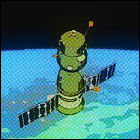 The Soviet Union launches Soyuz 9, a long-endurance mission which becomes the longest space flight in human history to date, lasting 18 days. Biomedical measurements are taken of cosmonauts Andrian Nikolayev and Vitaly Sevastyanov throughout their two-and-a-half-week stay in orbit, and Soyuz 9 is seen as a trailblazer for the Soviet space program’s new focus of long-term crewed space stations. Both cosmonauts suffer from muscle loss during their flight, as the Soyuz capsule isn’t big enough to allow for exercise.
The Soviet Union launches Soyuz 9, a long-endurance mission which becomes the longest space flight in human history to date, lasting 18 days. Biomedical measurements are taken of cosmonauts Andrian Nikolayev and Vitaly Sevastyanov throughout their two-and-a-half-week stay in orbit, and Soyuz 9 is seen as a trailblazer for the Soviet space program’s new focus of long-term crewed space stations. Both cosmonauts suffer from muscle loss during their flight, as the Soyuz capsule isn’t big enough to allow for exercise.
Soyuz 8
 The Soviet Union launches Soyuz 8, intended to be the passive partner in a space rendezvous and docking with Soyuz 7 (launched the previous day), as the already-launched Soyuz 6 films the docking. When the rendezvous radar gear aboard all three Soyuz vehicles fail to function properly, the docking is aborted; the only history made by the near-simultaneous trio of Soyuz craft is the largest number of humans in orbit at the same time to date (seven). Cosmonauts Vladimir Shatalov and Alexei Yeliseyev – both veterans of the docking missions of Soyuz 4 and 5 earlier in the year – return to Earth after nearly five days in space.
The Soviet Union launches Soyuz 8, intended to be the passive partner in a space rendezvous and docking with Soyuz 7 (launched the previous day), as the already-launched Soyuz 6 films the docking. When the rendezvous radar gear aboard all three Soyuz vehicles fail to function properly, the docking is aborted; the only history made by the near-simultaneous trio of Soyuz craft is the largest number of humans in orbit at the same time to date (seven). Cosmonauts Vladimir Shatalov and Alexei Yeliseyev – both veterans of the docking missions of Soyuz 4 and 5 earlier in the year – return to Earth after nearly five days in space.
Soyuz 7
 The Soviet Union launches Soyuz 7, intended to be the active partner in a space rendezvous and docking with Soyuz 8 (launched the following day), as the already-launched Soyuz 6 films the docking. When the rendezvous radar gear aboard all three Soyuz vehicles fail to function properly, the docking is aborted. Cosmonauts Anatoly Filipchenko, Vladislav Volkov and Viktor Gorbatko return to Earth after nearly five days in space.
The Soviet Union launches Soyuz 7, intended to be the active partner in a space rendezvous and docking with Soyuz 8 (launched the following day), as the already-launched Soyuz 6 films the docking. When the rendezvous radar gear aboard all three Soyuz vehicles fail to function properly, the docking is aborted. Cosmonauts Anatoly Filipchenko, Vladislav Volkov and Viktor Gorbatko return to Earth after nearly five days in space.
Soyuz 6
 The Soviet Union launches the first Soyuz mission since the American moon landing, Soyuz 6. With Georgi Shonin and future Apollo-Soyuz crewmember Valery Kubasov aboard, Soyuz 6 is intended to “chase’ two other manned Soyuz capsules launched in the days ahead, filming them as they perform an orbital docking maneuver. When the rendezvous radar gear aboard all three Soyuz vehicles fail to function properly, the docking is aborted. Shonin and Kubasov return to Earth after nearly five days in space.
The Soviet Union launches the first Soyuz mission since the American moon landing, Soyuz 6. With Georgi Shonin and future Apollo-Soyuz crewmember Valery Kubasov aboard, Soyuz 6 is intended to “chase’ two other manned Soyuz capsules launched in the days ahead, filming them as they perform an orbital docking maneuver. When the rendezvous radar gear aboard all three Soyuz vehicles fail to function properly, the docking is aborted. Shonin and Kubasov return to Earth after nearly five days in space.
Soyuz 5: almost another space disaster
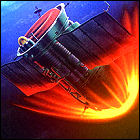 The Soviet Union launches a three-man crew aboard Soyuz 5, which docks in orbit with the already-launched Soyuz 4 – the first two crewed spacecraft to accomplish this feat. The Soyuz 5 crew consists of cosmonauts Boris Volynov, Alexei Yeliseyev and Yevgeny Khrunov, but only Volynov makes the return journey aboard Soyuz 5, as his crewmates board Soyuz 4 via spacewalk. It’s probably just as well for them: after three days in orbit, Soyuz 5 begins its descent to Earth, but the failure of explosive bolts meant to separate the re-entry capsule from the rest of the vehicle fail. To maintain some semblence of a survivable aerodynamic profile, Volynov flies Soyuz 5 in nose-first – one of the riskiest re-entries in the history of human spaceflight, since the nose of the capsule is not covered by any heat shielding. The vehicle separates just before the stress of re-entry would have destroyed it, but then its parachutes fail to completely deploy, resulting in a punishingly jarring but non-fatal landing, hard enough to break Volynov’s teeth.
The Soviet Union launches a three-man crew aboard Soyuz 5, which docks in orbit with the already-launched Soyuz 4 – the first two crewed spacecraft to accomplish this feat. The Soyuz 5 crew consists of cosmonauts Boris Volynov, Alexei Yeliseyev and Yevgeny Khrunov, but only Volynov makes the return journey aboard Soyuz 5, as his crewmates board Soyuz 4 via spacewalk. It’s probably just as well for them: after three days in orbit, Soyuz 5 begins its descent to Earth, but the failure of explosive bolts meant to separate the re-entry capsule from the rest of the vehicle fail. To maintain some semblence of a survivable aerodynamic profile, Volynov flies Soyuz 5 in nose-first – one of the riskiest re-entries in the history of human spaceflight, since the nose of the capsule is not covered by any heat shielding. The vehicle separates just before the stress of re-entry would have destroyed it, but then its parachutes fail to completely deploy, resulting in a punishingly jarring but non-fatal landing, hard enough to break Volynov’s teeth.
Similar malfunctions will plague a pair of Soyuz vehicles returning from the International Space Station in 2007. Soyuz 5 is the final crewed Soviet flight prior to the moon landing.
Soyuz 4: first manned space docking
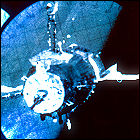 With only cosmonaut Vladimir Shatalov aboard, the Soviet Union launches Soyuz 4 into Earth orbit. Another manned vehicle, Soyuz 5, is launched the next day, and the two vehicles dock in orbit, the first docking of two manned spacecraft. Alexei Yeliseyev and Yevgeny Khrunov perform a spacewalk to leave Soyuz 5 and board Soyuz 4 for the return home (though the two capsules have primitive docking hardware, they do not have a docking tunnel or airlocks). Soyuz 4 makes a safe landing after two days in orbit – which is more than can be said for its sister ship.
With only cosmonaut Vladimir Shatalov aboard, the Soviet Union launches Soyuz 4 into Earth orbit. Another manned vehicle, Soyuz 5, is launched the next day, and the two vehicles dock in orbit, the first docking of two manned spacecraft. Alexei Yeliseyev and Yevgeny Khrunov perform a spacewalk to leave Soyuz 5 and board Soyuz 4 for the return home (though the two capsules have primitive docking hardware, they do not have a docking tunnel or airlocks). Soyuz 4 makes a safe landing after two days in orbit – which is more than can be said for its sister ship.
Soyuz 3
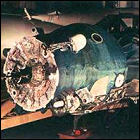 The Soviet Union resumes its manned space program with the launch of cosmonaut Georgy Beregovoy aboard the redesigned Soyuz 3 vehicle. The unmanned Soyuz 2 is launched the day before to serve as a docking target for Soyuz 3, but while the two vehicles pass close to each other, no docking is achieved. Beregovoy successfully returns to Earth – the first Soyuz cosmonaut to do so – after four days in orbit.
The Soviet Union resumes its manned space program with the launch of cosmonaut Georgy Beregovoy aboard the redesigned Soyuz 3 vehicle. The unmanned Soyuz 2 is launched the day before to serve as a docking target for Soyuz 3, but while the two vehicles pass close to each other, no docking is achieved. Beregovoy successfully returns to Earth – the first Soyuz cosmonaut to do so – after four days in orbit.
Soyuz 1: cosmonaut down
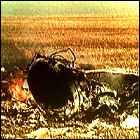 After a day in space aboard a spacecraft crawling with technical glitches, cosmonaut Vladimir Komarov orients the Soyuz 1 capsule for return to Earth. Though the vehicle survives reentry through Earth’s atmosphere, the main parachute fails to open, and the first Soyuz capsule returns to Earth at a speed of well over 100 miles per hour, killing Komarov instantly. The Soviet Union’s space program is stalled – much like the American Apollo program, postponed after the fatal Apollo 1 fire – well into 1968 as a result of the need to redesign Soyuz from the inside out.
After a day in space aboard a spacecraft crawling with technical glitches, cosmonaut Vladimir Komarov orients the Soyuz 1 capsule for return to Earth. Though the vehicle survives reentry through Earth’s atmosphere, the main parachute fails to open, and the first Soyuz capsule returns to Earth at a speed of well over 100 miles per hour, killing Komarov instantly. The Soviet Union’s space program is stalled – much like the American Apollo program, postponed after the fatal Apollo 1 fire – well into 1968 as a result of the need to redesign Soyuz from the inside out.
Soyuz 1
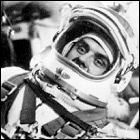 The first flight of the Soviet Union’s new manned space vehicle, Soyuz 1, lifts off from the Baikonur Cosmodrome. Though designed to accomodate a crew of three – and intended to be the answer to NASA’s Apollo command/service module in the ongoing race to reach the moon – the first Soyuz is flown by test pilot (and close friend of Yuri Gagarin) Vladimir Komarov. Though early plans for the mission involve a rendezvous and docking with a second Soyuz, only one vehicle is available for the mission, and it suffers a series of technical problems. Though aware of the faults in the Soyuz design, engineers have been pressured to put a manned Soyuz in orbit for political reasons.
The first flight of the Soviet Union’s new manned space vehicle, Soyuz 1, lifts off from the Baikonur Cosmodrome. Though designed to accomodate a crew of three – and intended to be the answer to NASA’s Apollo command/service module in the ongoing race to reach the moon – the first Soyuz is flown by test pilot (and close friend of Yuri Gagarin) Vladimir Komarov. Though early plans for the mission involve a rendezvous and docking with a second Soyuz, only one vehicle is available for the mission, and it suffers a series of technical problems. Though aware of the faults in the Soyuz design, engineers have been pressured to put a manned Soyuz in orbit for political reasons.